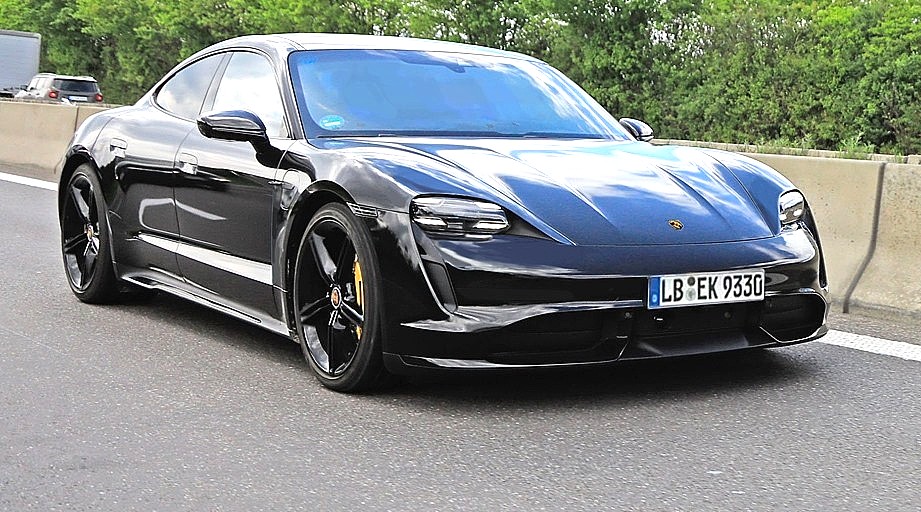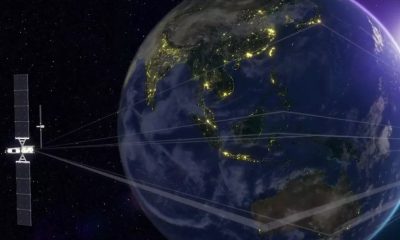

News
Porsche Taycan Turbo first ride teases production specs and price, Turbo S and RWD GTS variant
Porsche recently granted Automobile Magazine a rare test ride in the Taycan Turbo, the top-tier variant of the company’s first modern all-electric car. The test drive provided what could only be described as the closest look yet at the upcoming vehicle, and based on the impressions of the magazine; it appears that the Taycan Turbo could very well become one of Porsche’s most iconic cars yet.
Porsche designed the Taycan with the same principles as its other vehicles. It’s luxurious inside and out, it handles like a sports car, and it is quick — very, very quick. The motoring magazine highlighted this in its test ride, stating that the vehicle has a habit of pushing drivers and passengers back into their seats when it accelerates from 0-60 mph in just over 3 seconds. The publication also noted that the Taycan is more reminiscent of the Porsche 911 than Porsche’s four-door flagship, the Panamera, based on the way the car handled itself despite its weight.
While the Taycan is undeniably impressive, the test ride did raise a particular concern for the vehicle: it’s charging infrastructure, which remains a work in progress. The Taycan could be charged with up to 250 kW at an 800V charge point, but there are only a few charging stations with that output today. Even 400V stations, which can charge the Taycan at around 150 kW, are still relatively few. One can only hope that Porsche can secure the Taycan’s charging infrastructure by the time the vehicle’s production version is unveiled this coming September.

Perhaps most notable from the publication’s test drive were the details of the electric car that were revealed by the carmaker. For one, all Taycans, regardless of trim, are equipped with coated PSCB brakes, though carbon ceramic options are available. Similar to other electric vehicles, the Taycan is capable of regenerative braking as well, though the vehicle’s maximum regeneration is an impressive 250 kW. Higher-tier models also boast features like air suspension and rear-wheel steering.
Porsche is yet to fully announce the final specs of the Taycan, though a brand ambassador has confirmed the contents of a document obtained by the Automobile listing the features and specs of each Taycan version. According to the document, the base Taycan will be Rear Wheel Drive only, and it will be equipped with an 80 kWh battery pack. The base Taycan will be powered by a choice of 240-kW (322-hp) and 280-kW (375-hp) motors, and it will command a price in the low ~$90,000 range.

The vehicle’s mid-range variant, the Taycan 4S, will reportedly be equipped with a 96 kW battery pack and 320-kW (429-hp) or 360-kW (483-hp) electric motors. Pricing for the Taycan 4S will reportedly start in the high ~$90,000 range. The Taycan Turbo, which will be the vehicle’s top-of-the-line version upon its release, will reportedly feature a 96 kWh battery, a 160-kW (215-hp)/221-lb-ft motor up front, and a 300-kW (402-hp)/405-lb-ft motor at the rear. Pricing for the Taycan Turbo is expected to start at ~$140,000.
The Porsche Taycan is expected to be unveiled sometime this coming September, with the company offering the base, 4S, and Turbo versions to customers. At least two other variants of the Taycan will reportedly be unveiled later, one of which is a pretty insane 540-kW (724-hp) Turbo S version and a lighter RWD GTS trim that will most likely be incredibly fun to drive on the track. Porsche is also planning on improving its charging infrastructure in the near future, with peak charging rates for the vehicle increasing from 250 kW to 350 kW by 2021 at the latest.
The Porsche Taycan is arguably one of the most anticipated vehicles in the electric car market this year, particularly as it is one that has the potential to directly challenge the Tesla Model S in the premium EV segment. Porsche is moving full throttle to prepare for the Taycan’s production and ramp, with the company drastically upgrading its Zuffenhausen site to accommodate the manufacturing of the vehicle.
News
Tesla cleared in Canada EV rebate investigation
Tesla has been cleared in an investigation into the company’s staggering number of EV rebate claims in Canada in January.

Canadian officials have cleared Tesla following an investigation into a large number of claims submitted to the country’s electric vehicle (EV) rebates earlier this year.
Transport Canada has ruled that there was no evidence of fraud after Tesla submitted 8,653 EV rebate claims for the country’s Incentives for Zero-Emission Vehicles (iZEV) program, as detailed in a report on Friday from The Globe and Mail. Despite the huge number of claims, Canadian authorities have found that the figure represented vehicles that had been delivered prior to the submission deadline for the program.
According to Transport Minister Chrystia Freeland, the claims “were determined to legitimately represent cars sold before January 12,” which was the final day for OEMs to submit these claims before the government suspended the program.
Upon initial reporting of the Tesla claims submitted in January, it was estimated that they were valued at around $43 million. In March, Freeland and Transport Canada opened the investigation into Tesla, noting that they would be freezing the rebate payments until the claims were found to be valid.
READ MORE ON ELECTRIC VEHICLES: EVs getting cleaner more quickly than expected in Europe: study
Huw Williams, Canadian Automobile Dealers Association Public Affairs Director, accepted the results of the investigation, while also questioning how Tesla knew to submit the claims that weekend, just before the program ran out.
“I think there’s a larger question as to how Tesla knew to run those through on that weekend,” Williams said. “It doesn’t appear to me that we have an investigation into any communication between Transport Canada and Tesla, between officials who may have shared information inappropriately.”
Tesla sales have been down in Canada for the first half of this year, amidst turmoil between the country and the Trump administration’s tariffs. Although Elon Musk has since stepped back from his role with the administration, a number of companies and officials in Canada were calling for a boycott of Tesla’s vehicles earlier this year, due in part to his association with Trump.
News
Tesla Semis to get 18 new Megachargers at this PepsiCo plant
PepsiCo is set to add more Tesla Semi Megachargers, this time at a facility in North Carolina.

Tesla partner PepsiCo is set to build new Semi charging stations at one of its manufacturing sites, as revealed in new permitting plans shared this week.
On Friday, Tesla charging station scout MarcoRP shared plans on X for 18 Semi Megacharging stalls at PepsiCo’s facility in Charlotte, North Carolina, coming as the latest update plans for the company’s increasingly electrified fleet. The stalls are set to be built side by side, along with three Tesla Megapack grid-scale battery systems.
The plans also note the faster charging speeds for the chargers, which can charge the Class 8 Semi at speeds of up to 1MW. Tesla says that the speed can charge the Semi back to roughly 70 percent in around 30 minutes.
You can see the site plans for the PepsiCo North Carolina Megacharger below.

Credit: PepsiCo (via MarcoRPi1 on X)

Credit: PepsiCo (via MarcoRPi1 on X)
READ MORE ON THE TESLA SEMI: Tesla to build Semi Megacharger station in Southern California
PepsiCo’s Tesla Semi fleet, other Megachargers, and initial tests and deliveries
PepsiCo was the first external customer to take delivery of Tesla’s Semis back in 2023, starting with just an initial order of 15. Since then, the company has continued to expand the fleet, recently taking delivery of an additional 50 units in California. The PepsiCo fleet was up to around 86 units as of last year, according to statements from Semi Senior Manager Dan Priestley.
Additionally, the company has similar Megachargers at its facilities in Modesto, Sacramento, and Fresno, California, and Tesla also submitted plans for approval to build 12 new Megacharging stalls in Los Angeles County.
Over the past couple of years, Tesla has also been delivering the electric Class 8 units to a number of other companies for pilot programs, and Priestley shared some results from PepsiCo’s initial Semi tests last year. Notably, the executive spoke with a handful of PepsiCo workers who said they really liked the Semi and wouldn’t plan on going back to diesel trucks.
The company is also nearing completion of a higher-volume Semi plant at its Gigafactory in Nevada, which is expected to eventually have an annual production capacity of 50,000 Semi units.
Tesla executive teases plan to further electrify supply chain
News
Tesla sales soar in Norway with new Model Y leading the charge
Tesla recorded a 54% year-over-year jump in new vehicle registrations in June.

Tesla is seeing strong momentum in Norway, with sales of the new Model Y helping the company maintain dominance in one of the world’s most electric vehicle-friendly markets.
Model Y upgrades and consumer preferences
According to the Norwegian Road Federation (OFV), Tesla recorded a 54% year-over-year jump in new vehicle registrations in June. The Model Y led the charge, posting a 115% increase compared to the same period last year. Tesla Norway’s growth was even more notable in May, with sales surging a whopping 213%, as noted in a CNBC report.
Christina Bu, secretary general of the Norwegian EV Association (NEVA), stated that Tesla’s strong market performance was partly due to the updated Model Y, which is really just a good car, period.
“I think it just has to do with the fact that they deliver a car which has quite a lot of value for money and is what Norwegians need. What Norwegians need, a large luggage space, all wheel drive, and a tow hitch, high ground clearance as well. In addition, quite good digital solutions which people have gotten used to, and also a charging network,” she said.
Tesla in Europe
Tesla’s success in Norway is supported by long-standing government incentives for EV adoption, including exemptions from VAT, road toll discounts, and access to bus lanes. Public and home charging infrastructure is also widely available, making the EV ownership experience in the country very convenient.
Tesla’s performance in Europe is still a mixed bag, with markets like Germany and France still seeing declines in recent months. In areas such as Norway, Spain, and Portugal, however, Tesla’s new car registrations are rising. Spain’s sales rose 61% and Portugal’s sales rose 7% last month. This suggests that regional demand may be stabilizing or rebounding in pockets of Europe.
-

 Elon Musk2 weeks ago
Elon Musk2 weeks agoTesla investors will be shocked by Jim Cramer’s latest assessment
-

 Elon Musk2 days ago
Elon Musk2 days agoxAI launches Grok 4 with new $300/month SuperGrok Heavy subscription
-

 Elon Musk4 days ago
Elon Musk4 days agoElon Musk confirms Grok 4 launch on July 9 with livestream event
-

 News1 week ago
News1 week agoTesla Model 3 ranks as the safest new car in Europe for 2025, per Euro NCAP tests
-

 Elon Musk2 weeks ago
Elon Musk2 weeks agoA Tesla just delivered itself to a customer autonomously, Elon Musk confirms
-

 Elon Musk1 week ago
Elon Musk1 week agoxAI’s Memphis data center receives air permit despite community criticism
-

 News2 weeks ago
News2 weeks agoXiaomi CEO congratulates Tesla on first FSD delivery: “We have to continue learning!”
-

 Investor's Corner2 weeks ago
Investor's Corner2 weeks agoTesla gets $475 price target from Benchmark amid initial Robotaxi rollout

















